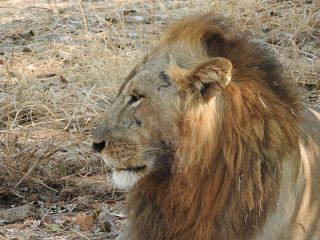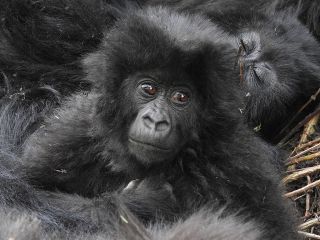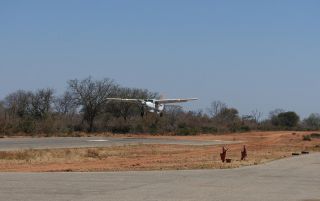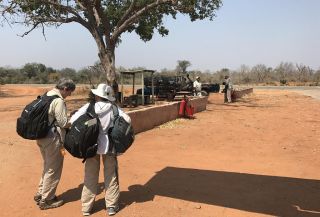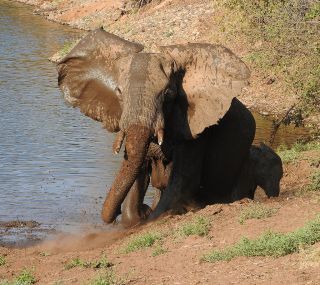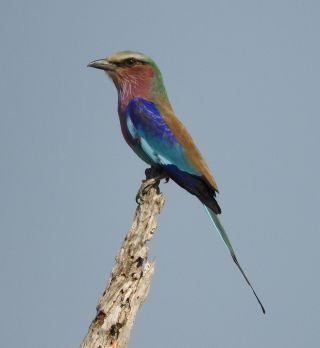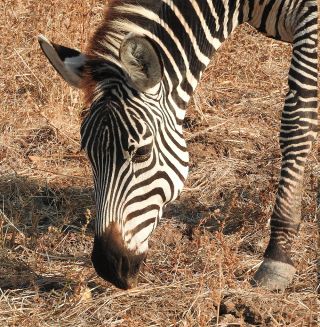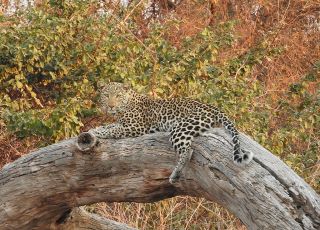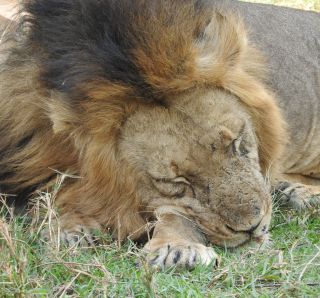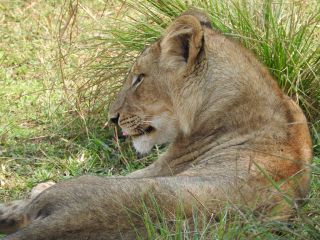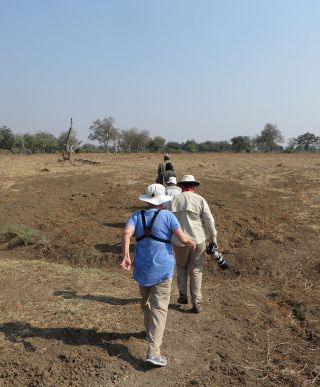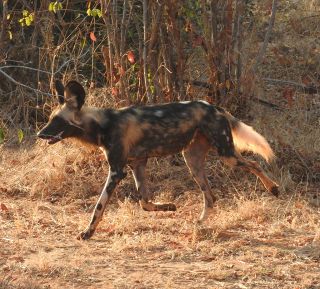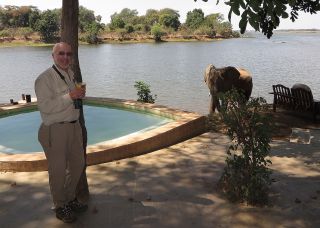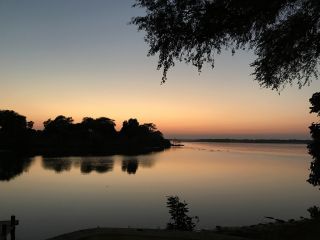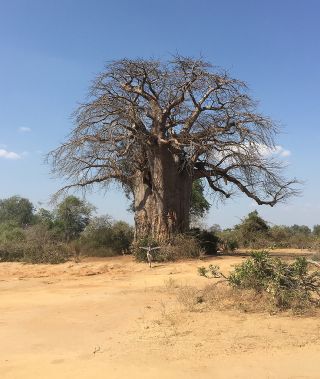Every photographer dreams of seeing action, but large cats (especially lions) spend so much time resting © Mark Brazil
Wild Watch Goes to Africa I Zambia
By Mark Brazil | Sep 30, 2017
From Alaska to Africa by way of Japan! I know I am fortunate, but sometimes even a strong self-inflicted pinch isn’t enough to wake to the reality.
My years tend to follow a somewhat predictable, if rather busy, pattern as I return again and again to the same destinations introducing naturalists to the wildlife highlights of a handful of destinations in Japan and overseas. Just every now and then an astonishing opportunity for me to visit somewhere entirely new comes along and this summer I was certainly in luck.
As a naturalist I have a long bucket-list of places I dream of visiting and of species I dream of seeing, from Giant Armadillo and Red Panda to Snow Leopard, but the species that have spent longest on my dream list have been African Painted Dog and Mountain Gorilla. I had given up hope of ever having the chance to even visit their habitat, when an extraordinary offer landed in my lap.
Mostly I detest flying. The mental boredom is as nothing compared with the physical boredom of cramp and claustrophobia while crammed into cattle class and treated like baggage. My least favourite flights are those involving multiple long-haul flights back-to-back, with journeys stretching over two-days. I can’t make up my mind whether the flights themselves are the worst part or the periods spent on the ground in between flights in unfamiliar airports when boredom really sets in.
As a very frequent flyer I have my particular flying hacks – always reserving an aisle seat, using noise-cancelling headphones to deaden the ceaseless sound of the aircraft and ward off the attentions of garrulous neighbours, and frequently walking the aisles or walking on the spot at the back of the plane to keep my blood flowing, but there is another kind of flying that is a real thrill.
That whole experience changes when just half a dozen of you check in for a flight, and its even better when the place you land is called an airstrip, not a runway. The best airports of all are those without either terminal buildings or baggage carousels.
Airstrips with all round access are a rarity in most of the countries I visit, but on a recent visit to Zambia I had the thrill of having to drive the runway before my flight arrived so as to ensure that no animals would be in the way of the landing aircraft! Even better was that we were able to watch a herd of elephants lumbering across the airstrip and away into the bush just before our flight came in. Bush pilots have to keep a weather eye on the ground; who knows what creature might suddenly decide to bask on the runway.
When an offer came in from Expedition Easy to lead a small group of wildlife watchers to Zambia’s South Luangwa and Lower Zambezi national parks I could hardly believe my luck, and my hesitance before responding to the offer must have lasted all of – well, about a nano-second!
Between the dream and the reality were many weeks of planning and preparation, but eventually I was actually walking to my tent on the first night in the bush listening to the chorus of night insects, the grunting of Hippopotamus and in the distance the bizarre calls of a Hyaena. For someone who has spent most of their life in the temperate zone, or visiting the Neotropics and South Asia, those sounds were marvels to my ears.
Of course there were the iconic animals of Africa (the famous “big five”) to look for, and colourful birds along the way too, but I am not motivated by a checklist, so it was experiences with wildlife that I was hoping for, not numbers on a list.
It may seem strange to say it, but seeing Lion can be something of a disappointment, as they are mostly inactive. They are inclined to spend most hours of the day resting in the shade rarely rolling or turning. The flick of a tail tip and the gentle rise and fall of a rib cage are often their only signs of life. Several lion sightings in to our South Luangwa safari it was becoming difficult to show enthusiasm for another lolling cat, yet I knew from much experience how hard it is for guides to find wildlife, and how much harder it becomes when guests show little interest!
When our guide Philemon Banda mentioned that the Mwamba lion pride had been located and that we could visit, I wasn’t entirely inspired, but then when he mentioned visiting them on foot seeing lion took on a whole new meaning – and feeling.
Television natural history documentaries have exposed us all to the incredible wonders and details of the natural world. Having grown up in the David Attenborough era, and having once been involved in the television documentary industry for well over a decade, I can attest to the excitement those documentaries engender in viewers. Now as a nature guide I often feel I’d like them to be banned from the airwaves. Yes they may educate the public, yet at the same time they create extraordinary and unrealistic expectations. After all, in fifty minutes of watching the “telly” one can see the entire life history of the lion, the tiger, the gorilla or whatever the subject of the documentary is. In glorious close-ups the most intimate details of a species’ life history are exposed and all one needs to do is cosy up in an armchair and watch. Such documentaries rarely tell the whole tale, they don’t mention the months and even years the crew spent in obtaining the visuals and the sounds, the many weeks spent in editing, but they do create immense expectations that are impossible to meet.
On one safari in central India a guest asked me, during our first sortie (of 12) in search of Bengal Tiger, why we hadn’t seen a tiger after the first hour. At a nearby Indian jungle lodge another first time and somewhat disgruntled guest pointed at a fabulous coffee-table book that a renowned photographer had spent years illustrating and told me in all honesty that they were they kind of pictures they’d expected to take during their safari. Producing television documentaries, illustrating books, even writing about wildlife generates expectations, so I am guilty on all accounts. Nevertheless, if one can manage expectations then there really is excitement to be had in the bush.
Watching wildlife from a safari vehicle creates a very false sense of security and superiority; it is somewhat akin to watching through a window or a television screen. The chances of experiencing anything more untoward than an insect bite while sitting comfortably in a land rover or land cruiser are extraordinarily low. Step out of that vehicle into the bush and the entire feeling changes. Hey there are predators out there!
As we left our vehicle and moved off in single file and silence across the open plain we were well aware of where our trackers were, and roughly where the lions were, and it seemed a certain kind of madness to be approaching them on foot. With a very palpable thrill we approached slowly, reaching a position a mere fifty metres from them from where we could watch them through our binoculars and camera lenses.
A well-maned male and seven females or youngsters were lounging in view in the shade of nearby trees, it was great seeing them, but the steady flow of adrenalin I experienced came not from watching them, but from the fact that we knew that there were another eight lions nearby that we couldn’t see. They were no doubt watching us though.
And what were all the lions doing, while we made our foot safari? They were doing exactly what each of the previous lions had been doing when we had seen them – they were resting in shade, lolling in familiar inactivity. The amazing difference this time was that we were watching them while on foot and without the seeming protection of being in a vehicle, and it was entirely thrilling!
A shift in reality is not always possible, but a shift in perspective changes that reality entirely.
Outro
If you would like to read more about Japan’s natural (and un-natural) history, then you may enjoy Mark’s collection of essays entitled The Nature of Japan: From Dancing Cranes to Flying Fish.
Author, naturalist, lecturer and expedition leader, Dr Mark Brazil has written his Wild Watch column continuously since April 1982, first in The Japan Times for 33 years, and since 2015 here on this website. All Wild Watch articles dating back to 1999 are archived here for your reading pleasure.
Two handy pocket guides The Common and Iconic Birds of Japan and The Common and Iconic Mammals of Japan have also been published and along with The Nature of Japan are available from www.japannatureguides.com.

